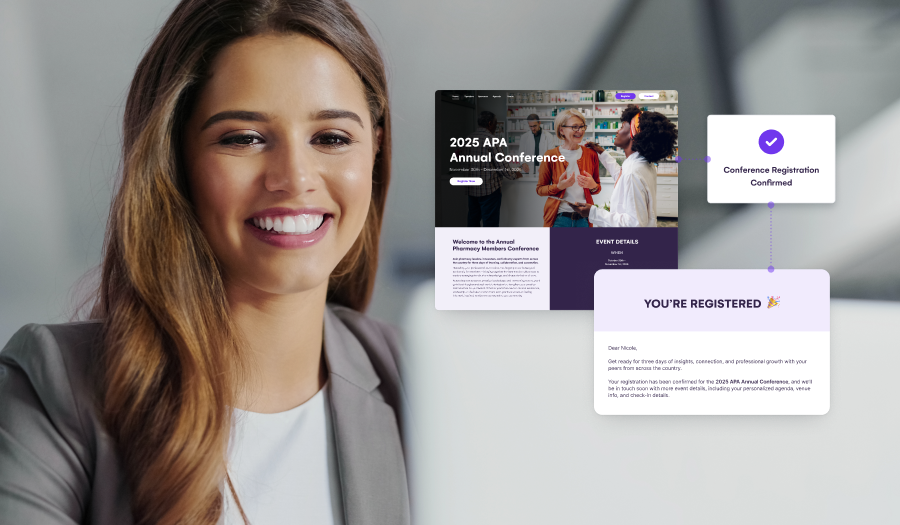
From guest speakers not turning up to severe weather disrupting the best laid plans and dare we mention the dreaded pandemic, as an event manager, you’ve probably dealt with your fair share of crises. Every event carries an inherent level of risk; no matter how much you plan, there’s always the chance something won’t go to plan.
However, with a comprehensive event risk management process, you can work to identify all potential risks, eliminate those you can, mitigate those you can’t, and put plans in place for what to do should the unexpected happen. This will minimize the chance of harm to people, property, or business.
What is event risk mangement?
An event risk assessment aims to identify and evaluate potential risks, hazards, or vulnerabilities associated with running an event. It’s an important tool to help ensure the safety and success of an event, as it empowers event planners and organizers to develop strategies to mitigate or proactively manage risks if they do arise. Better the devil you know, than the devil you don’t!
Top 10 safety risks for events
1. Crowds
Whether your event is in person or virtual, managing the number of people is one of the biggest risks associated with running an event, especially in a post-Covid-19 world. For a large face-to-face event, proper crowd control measures such as during check-in, barriers and security personnel should be implemented to avoid overcrowding and maintain order. Leveraging data from your events platform can also help to control crowd flow and density, flow and the number of staff needed. For a virtual event, consider registrations or ticketing, alongside the software platform you are using to minimize the risk of tech or capacity issues.
2. Weather hazards
Bad weather, the uninvited guest has the potential to wreak havoc at an event. Wet weather alternatives are a smart idea, but disaster weather events such as floods or dangerous storms or fires may also impact the viability of indoor events.
3. Security threats
Both in-person and virtual events carry the risk of security threats. For in-person events, in particular, large ones, these risks include terrorism, violence, and theft. For virtual events, security risks include hacking and data security breaches.
4. Financial risks
When there’s money involved, there’s financial risk. These might include payment issues, inadequate insurance, money handling, poor financial or budget forecasting. Event management platforms like EventsAir have built-in budgeting tools which allow you to track your spending against event budgets with real-time dashboards.
5. Fire hazards
Events that involve the use of pyrotechnics, open flames, or other flammable materials present a significant risk of fire. Proper fire safety measures such as fire extinguishers and sprinkler systems should be in place, as well as a fire-safety plan.
6. Food and alcohol
When food is served at an event, there’s risk of allergies, food poisoning, or foodborne illnesses if foods are incorrectly prepared, handled or stored. All food vendors should be properly licensed and checked to ensure food safety. In addition, alcohol consumption can increase the risk of accidents, injuries, and even violence at events. Proper measures such as ID checks, security, and responsible service of alcohol can help mitigate these risks.
7. Equipment malfunction
For both in-person and virtual events, any equipment, hardware, or software you use has the potential to malfunction. The AV might fail or be of substandard quality. Electricity may surge or blackout. Your wifi could become overloaded and momentarily tap out. Consider what measures you have in place as backups if any of these occur.
8. Medical emergencies
These might include injuries to guests, employees, volunteers, or participants, heat stroke/exhaustion, drug and alcohol issues, allergic reactions, and casualty incidents.
9. Non arrival of goods or performers
Planes and trucks get delayed, mistakes get made, and sometimes, things don’t arrive on time – or at all – creating significant problems for your event.
10. Regulatory and legal risks
There are a variety of regulatory and legal risks associated with running events, depending on the type, size, location etc. Some examples include contractual obligations to vendors and the venue in the event of cancellation. Breaches of noise restrictions and overcrowding are other examples.
11. Reputation
Yes, we’ve added an extra risk to our list of 10. That’s because all of the risks above, if not managed properly, can lead to damage to your company’s credibility, reputation and brand.
Managing risk with an event risk management plan
Every event is different, and the risks detailed above are just some of those that you might face in running your event/s. Follow the steps below to identify and flesh out potential risks associated with your event and to create a risk management plan to minimize them.
- Event risk assessment: conduct a thorough analysis of all activities before, during, and after your event to identify and evaluate all the potential hazards and risks (see list above). Consider who is at risk e.g. attendees, vendors, participants, your business, the likelihood of occurrence, and possible costs if the risk does occur.
- Identify key roles and responsibilities: consider your staff as well as other key parties involved in the event (e.g. the photographer, exhibitors, onsite venue staff, security, speakers). Decide who will be in control of the event, in control of incidents, who is the event safety officer, who is responsible for communicating arrangements and protocols, etc.
- Develop control measures: for each risk identified, a solution or mitigation plan needs to be developed. This might consist of removal of the hazard, implementation of controls for hazardous areas, incident and emergency procedures, safety training, or employment of additional personnel.
- Record your findings: thoroughly documenting all assessments, plans, and actions will not only create transparency and enhance communication between stakeholders, but will enable you to demonstrate accountability and due diligence should there be any issues.
- Review and assess your plan: as your event approaches things might change. Continually refer back to your risk management plan and document any changes as needed
5 Ways to reduce risk for a public event
1. Start with a public event risk assessment
2. Assess venue suitability
Before your event, visit your venue to assess its suitability. Here are some things to consider:
- Venue and audience circulation capacity: is the venue large enough and will the crowd be able to effectively move around the venue with minimal risk?
- Location of emergency exists: what is the level of visibility of emergency exits from the audience? Are they accessible for all patrons?
- Existing structures and features: Are there any features (e.g. support columns) that you will need to consider how your staff and audience will/should move safely around. Does the venue have everything you need, or will you need to hire additional equipment that you will also need to conduct a risk assessment on (e.g. a portable dance floor, portable bathrooms).
- Transport: Is there ample parking for the size of the crowd? Will staff be needed to assist in parking areas? Are there public transport options nearby? Are there clear paths for pedestrians?
Tip: use EventsAir’s interactive floor plan tool to map out the venue, seating and trade show plans and let users select their preferences online.
3. Health and safety
While this might seem like a no-brainer, considering the health and safety of all those attending your event is an essential part of your plan to reduce risk. This not only protects your audience and staff, but equally protects your reputation as a production company or event planner.
4. Insurance
Despite the best efforts to reduce risk, accidents do happen. Insurance is there to protect you, your company, staff, patrons, and the venue, should something go awry.
Ensure you are fully covered for the maximum number of people at your event and all elements of your event, such as:
- cancellations
- adverse weather conditions
- fire or theft of company equipment
- non-appearance of key speakers, or acts
- injury or illness.
In most circumstances, insurance is required by law, so it’s a good idea to speak to the venue about their existing insurance for coordination purposes.
5. Develop an emergency plan
Emergency procedures outline exactly what staff need to do if a significant incident occurs.
- Pre-assign roles to staff: e.g., event safety officer, fire wardens, someone to contact emergency services.
- Provide training where necessary.
- Share the emergency plan with the venue, local police, fire and rescue services, and ambulance services.
5 ways to reduce risk for a virtual event
1. Start with a virtual risk assessment
2. Use a secure platform
Choose a virtual event platform that is secure, reliable, and has a good reputation for protecting user data. Make sure the platform has robust security features, such as end-to-end encryption, powerful cloud infrastructure, GDPR measures, and firewall protection. Using secure and unique registration links and limiting the number of devices allowed to log in with each link can also help to prevent unauthorized access to the event and reduce the risk of data breaches.
3. Create a contingency plan
Create a back-up plan or protocols in case of technical difficulties. This might mean pre-preparing email comms, pre-recording important sessions, or having backup presenters available in case of last minute cancellations.
4. Train staff and participants
Make sure the relevant staff and participants are trained on the event platform, security protocols, and communication processes. Educate them on how to keep their personal information and login credentials safe, and what to do in case of suspicious activity.
5. Monitor the event
Keep a close eye on things – your event platform, social media channels, email, participants, and activity. Use moderators to monitor the chat function and proactively address any issues or disruptive behavior.
How to manage your event in a crisis
Sometimes, the worst-case scenario does happen. React, adapt, evolve is a strategy that can be used to respond to and manage effectively in a crisis. It involves three key steps: reacting quickly to the crisis, adapting to the situation as it unfolds, and using learnings to evolve your strategy for next time. Here’s how each step works:
React
The first step in managing a crisis is to react quickly. This means acknowledging the problem/s, assessing the situation, and taking immediate action to either prevent the crisis from escalating, or minimize its impact on the event. The primary focus here is on health and safety, and it may involve temporary solutions that shift as conditions change. A great example of this is when the University of Queensland took their 25,000-attendee event virtual in the face of Covid-19 lockdowns.
Depending on whether the crisis is isolated to one event, or affects many, in this stage you might:
- Identify impacted events and attendees (using an event management platform like EventsAir can help you do this in minutes).
- Assess the impact on events in terms of attendee impact, business impact, internal impact, sponsor and exhibitor impact and vendor impact.
- Gather necessary information: attendee lists, regulatory information, venue guidelines, and speaker, sponsor and exhibitor information.
- Refer to or conduct a risk assessment: what are the risks and hazards? What are the risks of continuing to host the event? What are the risks of canceling the event? (what are your contractual obligations, what does insurance cover?) What’s the risk of moving the event online?
- Make an informed decision: with real-time data in-hand, make a decision about the best course of action. This might involve continuing, canceling, postponing, or moving to a virtual platform.
- Communicate: once you have made a decision, this will need to be communicated to staff, attendees, vendors, exhibitors, sponsors and other relevant parties. Use your event management platform workflows to do this quickly and systematically. Consider:
- Emails
- Event website
- Event mobile app
- Social media (your own channels as well as speakers and sponsors)
- Physical signage
- Ticketing systems
Adapt
As the crisis continues, new information will become available and the situation may change. In this stage, it’s essential to adapt to the situation as it unfolds.
This may involve adjusting the strategy, reallocating resources, or changing priorities to address new challenges, and you may need to revisit some of the steps above. Adapting requires flexibility and agility to respond to changing circumstances and is key to managing a crisis effectively.
Evolve
Once the crisis and/or event is over, evaluate your crisis management response.
- What worked well?
- What didn’t work well?
- What lessons are there to be learned?
- Are there any data and systems that could increase your visibility or improve your response?
- What would you do differently next time?
Evolving is all about incorporating the learnings into your event management plans to create better future events. Conducting a post-event debrief can help provide a structured approach to ensure your team takes the time to evaluate effectively.
The bottom line
No event is immune from risk. But by using event risk management planning to identify all of the potential risks and then eliminate, mitigate, or minimize, you can be sure that you’ve done everything you can to create a safe and successful event.
Looking for powerful tools, workflows, and real-time data that can assist with every stage of the risk process? EventsAir’s all-in-one event software has secure and scalable technology that can help evaluate, plan for, and reduce risk for your events, and also empower you to quickly and effectively react, adapt and evolve in the event of a crisis. Reach out to our team of experts to learn how EventsAir can help you reduce risk – get a free demo now.
Best Practice | Event Planning & Management | Meetings and Events
See EventsAir in action
Discover why 12,000+ event professionals trust EventsAir to deliver effortless events, every time.





